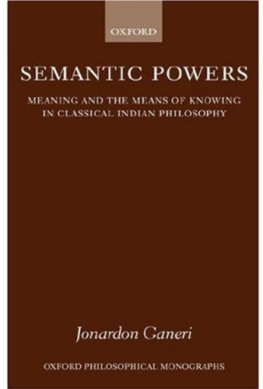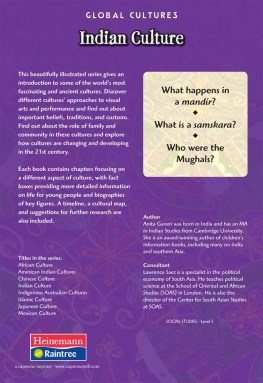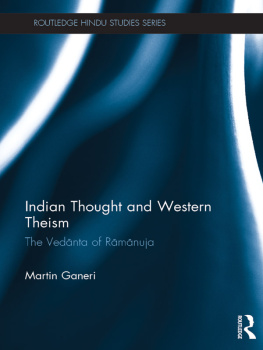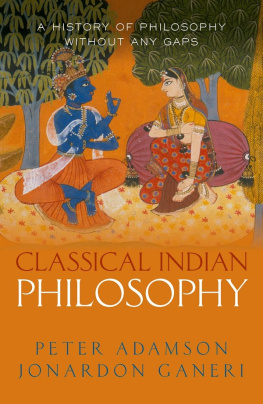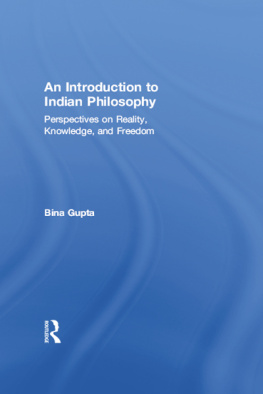The Concealed Art of The Soul
The Concealed Art of The Soul
Theories of Self and Practices of Truth in Indian Ethics and Epistemology
Jonardon Ganeri


Great Clarendon Street, Oxford OX2 6DP
Oxford University Press is a department of the University of Oxford.
It furthers the Universitys objective of excellence in research, scholarship, and education by publishing worldwide in
Oxford New York
Auckland Cape Town Dar es Salaam Hong Kong Karachi
Kuala Lumpur Madrid Melbourne Mexico City Nairobi
New Delhi Shanghai Taipei Toronto
With offices in
Argentina Austria Brazil Chile Czech Republic France Greece
Guatemala Hungary Italy Japan Poland Portugal Singapore
South Korea Switzerland Thailand Turkey Ukraine Vietnam
Oxford is a registered trade mark of Oxford University Press
in the UK and in certain other countries
Published in the United States
by Oxford University Press Inc., New York
Jonardon Ganeri 2007
The moral rights of the authors have been asserted
Database right Oxford University Press (maker)
First published 2007
All rights reserved. No part of this publication may be reproduced, stored in a retrieval system, or transmitted, in any form or by any means, without the prior permission in writing of Oxford University Press, or as expressly permitted by law, or under terms agreed with the appropriate reprographics rights organization. Enquiries concerning reproduction outside the scope of the above should be sent to the Rights Department, Oxford University Press, at the address above
You must not circulate this book in any other binding or cover and you must impose the same condition on any acquirer
British Library Cataloguing in Publication Data Data available
Library of Congress Cataloging in Publication Data Ganeri, Jonardon.
The concealed art of the soul : theories of self and practices of truth in Indian ethics and epistemology / Jonardon Ganeri.
p. cm.
Includes bibliographical references and index.
ISBN 9780199202416 (alk. paper)
1. Atman. 2. Philosophy, Indic. I. Title.
B132.A8G34 2007
181.4 dc22 2007008548
Typeset by Laserwords Private Limited, Chennai, India
Printed in Great Britain
on acid-free paper by
Biddles Ltd., Kings Lynn, Norfolk
ISBN 9780199202416
10 9 8 7 6 5 4 3 2 1
If truth be at all within the reach of human capacity, tis certain it must lie very deep and abtruse.
DAVID HUME
Though it be a maxim of the schools that there is no love of a thing unkown, yet I have found that things unknown have a secret influence on the soul.
THOMAS TRAHERNE
This I is not intimate with itself through and through, but is opaque, and therefore remains a riddle to itself.
ARTHUR SCHOPENHAUER
The author, since he has no intention of telling about himself, decided to call the character I as if to conceal him, not having to name him or describe him more than this stark pronoun.
ITALO CALVINO
Every profound spirit needs a mask.
FRIEDRICH NIETZSCHE
Contents
Detailed Contents
Introduction
Among the philosophers of classical India, some speak of a possibility we should not and indeed cannot ignore. It is the possibility that we have got it wrong about the relationship between ourselves and the world; it is the possibility that we are massively, colossally, in error about the world we inhabit and the nature of that inhabitation, about our station in the world of things, about our lives, hopes and destinies. These Indians are not prophets of doom: they do not say that the mistake we have made is a catastrophic one. Indeed, it is barely noticeablethings go on, things work out, more or less, by and large. The mistake we have made is not catastrophic but tragic. Its tragedy lies in the fact that there are lives to be led that are so much better, so much more to the point, than the ones we do in fact lead, lives not inaccessible but merely hidden, lying just out of view. We are like Humphrey Bogart and Katharine Hepburn in The African Queen, exhausting ourselves in the effort to shove our home-made boat along the meandering gullies, made blind by that very effort to the great ocean just over the bank. We inhabit a world we do not know. We sleepwalk, now here, now there, alongside a silent and forgotten destiny.
Hidden: metaphors of concealment suffuse the Indian debate. The truth is covered, clothed, wrapped up, enveloped, concealed; Sanskrit verbs of concealment include nihnu (to hide, conceal; to deny, dissimulate), v (to cover, hide, conceal), guh (to cover, hide, conceal, keep secret), pracchad (to cover, wrap up, veil, envelop; to hide, conceal, disguise, keep secret), and many more. Sometimes myths embody abstract ideas, and for the Indians a myth of concealment is primal: Indra is the invincible power of breaking through, shattering obstacles, overcoming concealment. With him is associated the primal myth of the Indian tradition, the killing of the dragon Vtra, which names literally the force that covers and hides, blocks and thwarts. Killing the dragon Vtra, overcoming concealment, is the function of what I will call a practice of truth.
Above all else, it is the self that is concealed, or the truth about the self. Heideggers thought is that Being conceals itself, indeed that:
vacillating self-concealment is a name for Being itself Being is not merely hidden; it withdraws and conceals itself. From this we derive an essential insight: the clearing, in which beings are, is not simply bounded and delimited by something hidden but by something self-concealing.
For the Indians, the Being for which this is true is the self (for the Greeks, as Pierre Hadot notes, it is Nature). We are in self-imposed error, the Buddha said, when we think that our everyday pleasures are not in reality pains, concealing from us the universality of sufferingthe fact of concealment underwrites the first of the Four Great Truths. We are in error too about the cause of that suffering, the attachment to a self thats not there to be found. The Upaniads likewise suggest to us that we have got it wrong about something very important:
Take, for example, a hidden treasure of gold. People who do not know the terrain, even when they pass right over it time and again, would not discover it. In exactly the same way, all these creatures, even though they go there every day, do not discover this world of brahman, for they are led astray by the false. (CU 8.3.12)
Mistakes about the place that an idea of self should hold in our mental lives run deep, however, and the cure for our misconceptions is never simply to announce the right view. The early texts, therefore, resort to other means. They do not simply announce; they find subtle strategies and indirect methods to help the reader undercut their false sense of self: techniques of graded instruction, embedded and contextualized description, literary devices of disguise and deceit, the use of figures and characterizations. As Martha Nussbaum has said, a philosophy that aims at therapy for the soul will often need to search for techniques that are more complicated and indirect, more psychologically engaging, than those of conventional deductive and dialectical argument. It must find ways to delve into the pupils inner world.
Next page

